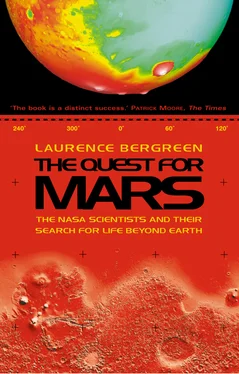Subterranean life on Mars could survive the loss of the atmosphere, it could survive intense cold on the surface, it could even survive the largest life extinguisher we know about, the impact of a large asteroid. Imagine what would happen if an asteroid the size of Manhattan collided with Earth, Steve says. It would certainly be calamitous and likely sterilize the surface of the planet down to a depth of several meters or so, but not below that. It would kill life on the surface, but it wouldn’t eliminate all life on Earth, because the impact’s thermal and chemical effects would be limited to the uppermost part of the surface, with the exception of the area where the impact occurred. After the impact, life far below the surface of the Earth would go on. The same holds true on Mars, Steve says: “any microorganisms that might have evolved four billion years ago, when the planet might have been warmer and wetter at the surface, could readily survive to the present day at depths of several kilometers.” If he’s correct, or even partly correct, life could very well exist within the Red Planet’s ancient reservoirs, awaiting discovery.
The Best Guess Scenario assumes that some kind of simple life did exist on Mars a few billion years ago, as Steve described. And it assumes that asteroids have bombarded Mars ever since, pockmarking its surface with craters. Sixteen million years ago, according to the scenario, a refugee from a disorganized asteroid belt struck the surface of Mars with tremendous force. Since Mars has only 38 per cent of Earth’s gravity, the impact was sufficient to drive pieces of rock buried beneath the surface high into the Martian sky and beyond. The pieces shot into space five times faster than a bullet – fast enough to escape the Red Planet’s gravity. Until a few years ago, it was thought the shock of impact would vaporize or severely deform the ejected material – the ejecta – along with everything in it, including any signs of life, but recent computer modeling has shown that the physics involved would allow the ejecta to remain intact. In the model, the asteroid comes in at an angle, strikes, and creates a vapor cloud that sweeps across the surface at an extremely high speed and carries material off Mars into solar orbit. The whole process might take five or ten seconds, long enough for some fragments of Mars to remain intact. “That’s a fairly gentle way to get stuff off the surface,” says Mark Cintala, who studies craters at NASA’s Johnson Space Center – gentle enough to launch a fossil-bearing meteor on a trajectory to Earth.
There’s a variation in the Best Guess Scenario that incorporates another method of ejecting material safely from the surface of Mars: spallation. Much of the work on the spallation model was done by Jay Melosh at the University of Arizona, and it’s extremely simple, in theory. You put a quarter on a tabletop, rap the underside of the table, and bump the quarter into the air; that’s spallation. “You’re sending a stress wave through the table, and that stress wave is transmitted to the quarter. Imagine that happening on Mars,” Mark Cintala says. In that case, the asteroid’s impact would create a compressional wave, as if it were a depth charge below the surface. The resulting shock wave would bounce a rock fast enough to escape the relatively weak Martian gravity and send it on its way. “At least, the calculations say it can.”
In the Best Guess Scenario, one of these dislodged pieces of Martian rock sped off in the direction of Earth, a cosmic message in a bottle floating through an ocean of outer space. The journey lasted millions of years, and the ancient chunk of Mars crashed to the surface of Earth a mere 13,000 years ago. The size and shape of a potato, it buried itself in the Allan Hills of Antarctica. The meteor had become a meteorite.
Meteorites have held a special fascination as relics from the heavens, mute messengers from parts unknown. In the Middle Ages, meteors falling to Earth generated superstition and concern. Where did they come from? What did they mean? The faithful brought them to the authorities, and in time, the Catholic Church acquired a large repository of these curiosities. In 1969, the study of meteorites underwent a quiet revolution when Japanese researchers found high concentrations of them preserved in arctic ice. Since 1977, NASA, a technological Vatican, has been collecting meteorites from Antarctica and housing them at the Johnson Space Center in Houston. Each year, there are hundreds of new arrivals, and when there’s a promising delivery, scientists clamor to get a piece to study. There are now nearly 10,000 rocks under lock and key in Building 31 at Johnson, many of them preserved in nitrogen. By measuring the radiation absorbed by the meteor during its space travels, scientists can determine approximately when the rock arrived on the Earth, and even how long it spent in space before it arrived on our planet.
In December 1984, Roberta Score was hunting for meteorites in Antarctica. At the time, she was employed by Lockheed Martin and working at the Johnson Space Center. Around Johnson, a meteorite collecting mission is not exactly choice duty; join one, and you were said to have become part of the “Houston weight loss program.” Walking across an apparently endless sheet of ice, Robbie Score came across a greenish stone about the size of a potato. Once she removed her sunglasses, she saw the meteorite was not greenish, after all; it was gray and brown, but she knew it looked different from the ordinary meteorites she found in the field. Along with other samples, it was kept in a freezer aboard the ship that brought it from Antarctica to Point Magu, California, where it was packed in dry ice and sent to Johnson, where it was stored in cabinets that once held moon rocks. The meteor curators, including Robbie Score, designated it ALH 84001 – their way of saying this was the most interesting meteorite collected in 1984 in the Allan Hills of Antarctica. But after being delivered to Johnson, ALH 84001 was misidentified as an asteroid fragment, a diogenite, rather than a piece of Mars, and stored in Building 31. It was not ignored, however; small sections were allocated to the scientific community for further study over the years; in all, almost a hundred “investigators” examined it, and everyone continued to misclassify it as a diogenite – with one exception.
In late 1993, David Mittlefehldt, a veteran Lockheed Martin scientist also working at Johnson, reexamined ALH 84001. Mittlefehldt was an expert on diogenites, and this particular rock didn’t look like one to him. It seemed to have more oxidized minerals in it than your normal diogenite, for one thing. Using new technology in the form of high-resolution laser spectrometry, two other scientists, Donald Bogard and Pratt Johnson, extracted gases trapped inside the strange meteorite and discovered that their very idiosyncratic characteristics exactly matched gases on Mars as measured by the Viking spacecraft in 1976. Mittlefehldt published his findings in 1994 in a scientific journal, and attracted the notice of the science community. Although this wasn’t the first meteorite from Mars to have been discovered, the reclassification created a stir. Of the thousands of meteorites that have been cataloged, only fourteen are believed to have come from Mars; the overwhelming majority come from asteroids, and a few from the moon. Meteorites are named for the places where they have fallen to Earth, so the Martian meteorites have some fairly exotic names – S hergotty (India), N akhla (Egypt), and C hassigny (France), among them – and are known collectively as SNC or “snick” meteorites. “SNC meteorites” is an elaborate way of saying “meteorites from Mars.”
Carefully considering his find, Mittlefehldt noticed minuscule reddish-brownish areas deep within ALH 84001; they looked a lot like carbonates, and on Earth, carbonates such as limestone tend to form close to water. What made this all so curious was that no one had detected carbonates – and their suggestion of water – in the other Martian meteorites. They were billions of years newer; they probably came from a more recent era in the geologic history of Mars, after the water that once flowed freely across its surface had disappeared. This one, however, apparently harkened back to that warm and wet golden age on Mars. Dating confirmed that the meteorite was indeed very old: 4.5 billion years old, much older than other known Martian meteorites, and it contained carbonates that were 3.9 billion years old. Mittlefehldt wanted to get some idea of the temperature range in which the carbonates had formed billions of years ago, so he went to yet another NASA scientist, Everett Gibson, who examined the very curious meteorite with Chris Romanek; they published a paper in the December issue of Nature in which they said the carbonates had formed at temperatures below 100° C, in other words, at moderate, Earthlike temperatures – “well in the range for life processes to operate,” as Gibson puts it.
Читать дальше












